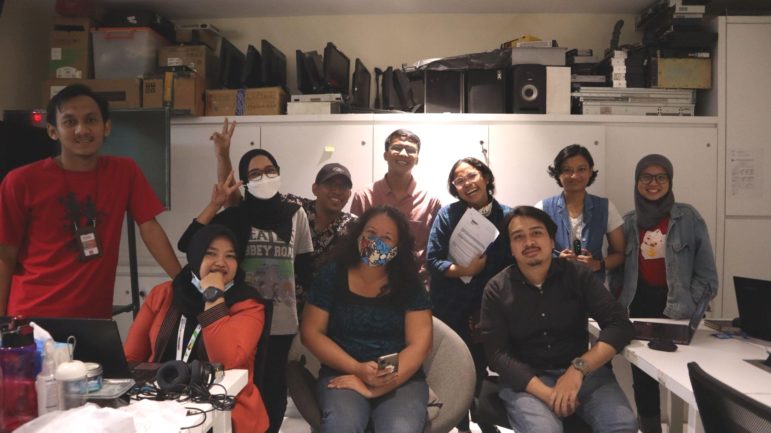

Image: Screenshot
A New Business Model Emerges: Meet the Digital News Co-op
Editor’s note: This article was originally published by Nonprofit Quarterly (NPQ) online on March 3, 2021. We are pleased to republish it here with permission. Although the story focuses on the US market, there are global lessons in what is reported here. Indeed, as the story notes, long-established, reader-owned cooperative newspapers exist in Europe and Mexico, and have taken root in Canada and Uruguay.
It’s a perfect civic storm: Our battered democracy is as fragile as it has been since the Civil War, trust in crucial institutions is in tatters, and a historic source of the robust and trustworthy local news that nourishes civic health — community newspapers — has been withering for more than a decade. A quarter of all newspapers in the United States have failed since 2004, and the COVID-19 pandemic is only making this grim trend worse.
Despite determined and expansive efforts to offset vanishing newspapers with new digital news sites — some nonprofit and some for-profit — their number has been growing nowhere near fast enough to replace newspapers as they die off. University of North Carolina (UNC) research has documented the relentless spread of news deserts from coast to coast.
But wait — what’s that glow on the horizon?
It’s the nation’s first cooperatively owned local online news site, trying out a new business model in Akron, Ohio. The Devil Strip — whose eye-catching name it adopted from Akron’s distinctive term for the grass berm between street and sidewalk — is celebrating its first birthday as a co-op, having enrolled nearly 1,000 member-owners and, according to publisher Chris Horne, beating its one-year revenue goal. Might this be a signal that co-op sites will not only thrive but spread; that more communities will be nurtured by the informed citizenries crucial to healthy local civic life?
Exploratory efforts are also under way in Northern California; Maryland; Hartford, Connecticut; Pittsburgh, Pennsylvania; Boston, Massachusetts; Springfield Massachusetts; rural Maine; and beyond. The Banyan Project, which I founded, was first to develop a model for digital community news co-ops. All told, over 40 communities nationwide have approached us. Each project is different: for example, in Boston, the goal is to create a trusted information source for the metro area’s large Black community.
What is a News Co-op, Anyway?
Community news co-op advocates see this distinct new model they’re shaping as having a high chance for success in places where existing approaches to digital sites might struggle or fail, including in many news deserts. That said, this is a model in development, and the hope it offers is far from proven. As with any new business model, lots can go wrong.
At this early stage, news co-op pioneers envision the model from several angles:
- For readers, news co-ops are independent grassroots community institutions that fulfill local news and information needs — while offering easy-to-use digital forums where people can see how others are responding to the news, and join with others in efforts to help their community. Co-ops make all their news and other content available for all to read free on the web, as a community service.
- For publishers, the model provides a revenue stream from monetizing something novel — memberships that provide a bit of equity, and a vote in an institution that not only provides an important community service but also offers members a voice and a sense of civic promise. Co-op fees replace the dollars newspapers receive from selling the news itself through subscriptions. At its base, what a news co-op monetizes is its members’ hope for their community.
- For members, the benefits are their equity and vote, but that’s just the start. The most fundamental value comes from knowing their commitment helps make possible an institution that ensures that they and everyone in their community can know what’s going on with issues that matter. Further, members get posting access on the digital forums and a weekly newsletter that solicits their thoughts and knowledge about issues in the news, and asks them for ideas about what they would want covered and how. These aren’t available to non-members.
- For local advertisers, co-ops can offer premium memberships with added bonuses, including a listing in the co-op’s business directory and a discount when buying ads. Also, unlike so much of the internet, the environment for their ads will be predictable and trustworthy. Buying ads in a grassroots community institution doesn’t just call attention to what the business offers; it also announces that the business supports the community. The more value a news co-op can offer advertisers, the more revenue it will generate, and the stronger its news offering can be.
- For the community, news co-ops’ no-paywall news coverage nourishes an informed electorate. Further, the digital forums serve as an online public square that amplifies the impact of the co-ops’ news by cultivating a level of civic engagement that print technology is unequipped to deliver.
Also, the law requires all co-ops to have democratic governance, with each member having a vote in electing the board of directors who hire and oversee the site’s editor and executive director. Depending on community size, news co-ops can expect hundreds or thousands of members; this distributes power widely in the co-op’s area of coverage, a mechanism that can provide a distinctive bottom-up community voice.
Well-run news co-ops will consistently ask their members for ideas and invite them to forums on local issues they care about, both digitally and (in the post-pandemic future) in person. They can also offer training in citizen journalism, media literacy, and other civic topics. This adds social cohesion to communities. In an era of fading civic trust, when local community ties have weakened as people are drawn into national and even global communities of interest, news co-ops’ potential to strengthen local civic health has never been more important.
For democracy, there is huge potential for gain if the news co-op model proves sustainable in places where for-profit and nonprofit models have not taken root. Of the more than 2,100 newspapers that have died since 2004, fewer than 100 were dailies; the vast majority were weeklies and other non-dailies that served suburban and rural communities. The UNC paper cited above found only 525 digital sites at the community level. The number has grown since — the Institute for Nonprofit News recently reported its largest membership ever — but over the same period more than 60 newspapers died.
Co-ops take many forms. News co-ops fall into the category of consumer co-ops, meaning they are owned by end-users. They will be owned by a large number of their readers the way depositors own credit unions and customers own food co-ops. Consumer co-ops rarely become large chains, but, as credit unions and food co-ops have shown, they can replicate from community to community, coast to coast. Credit unions, for example, tend to be small, but, as an industry, the nation’s 5,133 credit unions have 123.7 million member-owners and hold a total of $1.79 trillion in assets. That’s larger than Wells Fargo, the nation’s third-largest bank. If news co-ops proliferate this way, democracy gains.
Pros and Cons of the Model
So, what advantages might a news co-op possess?
In the hope of gaining reader support, established digital news models cultivate engagement to attract donor-members akin to those of public broadcasting. Proponents see news co-op memberships as much more valuable — the equity, vote, and voice they provide plug members right into the heart of the institution. If news co-ops prove this deep engagement to be more valuable, Marketing-101 says they should attract more members, retain a greater percentage of them, and thus receive more revenue. This revenue could then support sites that could sustain themselves, even in less-than-affluent communities that would otherwise likely be news deserts.
A bonus source of value for the co-op model is its inherent trustworthiness. Editors and executives are accountable to their outlets’ owners, and in news co-ops, those owners are the reader-members, which means those editors had best pay careful attention and bring their best intuition to what their readers need to know — whether readers express those needs or not.
This accountability structure does much to explain why so many studies have established co-ops’ trustworthiness. In an era of rampant distrust, journalism needs this. Democracy needs this.
What are the Challenges and Weaknesses?
- Serious organizing is needed to start a consumer co-op, which entails enrolling lots of founding members willing to pool modest upfront payments to amass the capital needed for launch. This takes more time than a couple of partners with an investor hanging out a shingle and starting work. That said, while some efforts to form co-ops may fail before launch, those that launch have so many members with skin in the game that they fail far less frequently. Further, converting an existing digital news site to co-op ownership can be far less of a challenge — this is what the Devil Strip is doing.
- Because co-ops make up a modest fraction of all businesses, finding managers with co-op experience can be a challenge. And no one has firsthand experience managing news co-ops, because the first ones are just getting going. Most consumer co-ops don’t engage their members much — this takes staff time and attention — but the news co-op model is built on engaging members. At the same time, successful news coverage requires a site’s editor to be free to make independent coverage decisions. Balancing these demands deft management.
- Digital publishing platforms for nonprofit and for-profit sites are turnkey-ready. Because of the need for membership cultivation, tracking, and transactions, and the maintenance of digital forums, news co-ops demand more complex platforms.
Most important, the model has yet to be thoroughly tested. Akron is leading the way, and while interest is bubbling in lots of other places, traditional journalism funders have yet to focus on the co-op model’s potential.
The Appeal Is Spreading
News co-ops are just emerging in the US, but long-established, reader-owned cooperative national newspapers in Germany, Italy, Switzerland, and Mexico show that people will support news co-ops that meet their needs. Newer news co-ops have taken root in Canada, Uruguay, and the United Kingdom. In the US, the Devil Strip is first out of the gate, but others are following:
- The Devil Strip started as an alternative monthly newspaper, but it was flailing; after some research, publisher Chris Horne decided to convert to co-op ownership. The effort has attracted 13 grants totaling more than a half million dollars from the Knight Foundation and others — and drew the attention of the Columbia Journalism Review.
- The Mendocino Voice, an online site started in 2016, has also made a commitment to convert to co-op ownership. Kate Maxwell, the publisher, said in an interview that legal work to reincorporate is all but done. It too has received significant attention from the journalism press.
- Bloc by Block, based in Baltimore, is starting from scratch to launch a news co-op to serve communities throughout Maryland. Kevon Paynter, its founder, aims to deliver the news by way of a mobile app.
- Civic Mind aims to launch an online news site named the Hartford Times, after a newspaper that published in Hartford for 159 years and closed in 1976. Civic Mind has acquired the rights to the name, and its founder, Thomas Clynch, is working to create a slightly different ownership model — a membership nonprofit that, like a co-op, has one-member, one-vote governance.
The Banyan Project, where I work, is not a co-op but acts as a nonprofit incubator of news co-ops by providing plans, tools, and guidance that ease the way for local groups launching independent community news co-ops. Banyan then aims to provide the sites with services designed to help them succeed. People in 21 states have inquired about launching Banyan’s model in their communities. Banyan has received modest grants and is seeking multiyear funding so it can staff up and start seeding news co-ops wherever there is a need and there are committed volunteers prepared to lead the effort. Currently, Banyan is working with Civic Mind in Hartford.
At this stage, no two news co-ops are alike. One started as a worker-owned co-op in Canada, but without revenue from reader-owners, it wasn’t working financially. It tried to add reader members, but it fizzled out. Another, England’s Bristol Cable, has evolved as it has grown and reserves some board seats for “operations and content contributors.” The Devil Strip follows a similar model. The long-established reader-owned co-op newspapers in Europe and Mexico started as print newspapers and operate differently. Much remains to be learned.
Why is Trying a New Business Model Worth all this Effort?
From coast to coast, there are huge holes in local news coverage. Democracy is impossible without an informed electorate, so those holes need filling — and fast.
For-profit and nonprofit digital sites fill some holes and prevent others, but the UNC research shows they disproportionately serve affluent places and/or elite readers. There are notable exceptions, but for-profit sites tend to work best in suburban communities where people have plenty of disposable income. Nonprofit sites tend to spring up in and near cities where philanthropy is relatively plentiful. And, after more than a decade of effort, existing digital models have yet to start taking root at a pace that offsets newspapers as they die — much less at the faster pace needed to start reclaiming news deserts.
Some digital sites deserve great praise for serving particular constituencies beautifully. Some nonprofit sites that cover state governments — Texas and Vermont stand out — are doing a better job than newspapers ever did. National and global nonprofit investigative reporting organizations, especially ProPublica and the International Consortium of Investigative Journalists, routinely shake up governments and rack up major prizes. Other sites have arisen to cover urban areas that had been news deserts for decades, including the South Side of Chicago. These serve democracy with gusto.
Also on the good news front, the Internal Revenue Service, the IRS, has started allowing newspapers to convert from for-profit to nonprofit status — and the Baltimore Sun is likely to soon join their number. This may save some that would otherwise die. Further, philanthropic support for existing digital approaches is rising.
Nonetheless, news deserts continue to spread their bad news.
“It’s the biggest challenge in journalism today,” Martin Baron, who recently retired as executive editor of The Washington Post, said in a valedictory interview with the PBS NewsHour, adding that collapse of local journalism is “a threat to democracy itself.”
The situation cries out for new approaches. At this moment, the news co-op is poised to make that leap.
Additional Reading
GIJN Resource Center: Sustainability Strategies
Survival Tips for Nonprofit Newsrooms: Fundraising, Membership, and Sustainable Models
How a Canadian Newsroom Launched a Co-Op to Save Itself from Bankruptcy
 Tom Stites is an award-winning journalist who has been a ranking editor for major newspapers, including The New York Times, and the editor and publisher of for-profit and nonprofit magazines. He is the founder and president of the Banyan Project, a news co-op incubator. He is also a consulting editor for the International Consortium of Investigative Journalists.
Tom Stites is an award-winning journalist who has been a ranking editor for major newspapers, including The New York Times, and the editor and publisher of for-profit and nonprofit magazines. He is the founder and president of the Banyan Project, a news co-op incubator. He is also a consulting editor for the International Consortium of Investigative Journalists.









